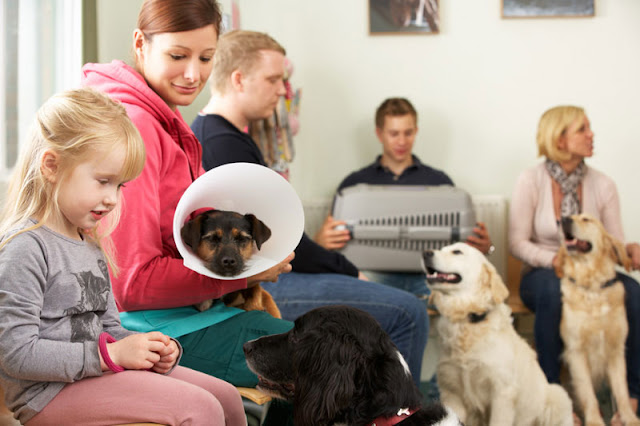Canine Stress in the Vet's Waiting Room
Almost 30% of dogs are highly stressed in
the waiting room, but owners don’t necessarily know if their dog is stressed or
not.
By Zazie Todd, PhD
This page contains affiliate links which means I may earn a commission on qualifying purchases at no cost to you.

When it was time to go to the consultation room, some dogs tried to refuse by not moving. The VB had successfully identified many of these dogs as highly stressed, but owner ratings were not linked to this behaviour.
The videos showed that more than half of the dogs showed at least four signs of stress in the waiting room. The most common were nose licking, panting, lowered ears, crying, grooming, and yawning. Statistical analysis grouped all the signs into five categories: passive avoidance, active avoidance, high anxiety, high arousal, and medium anxiety.
Reference
Mariti, C., Raspanti, E., Zilocchi, M., Carlone, B., & Gazzano, A. (2015). The assessment of dog welfare in the waiting room of a veterinary clinic Animal Welfare, 24 (3), 299-305 DOI: 10.7120/09627286.24.3.299
By Zazie Todd, PhD
This page contains affiliate links which means I may earn a commission on qualifying purchases at no cost to you.
Some dogs show signs of stress in the
waiting room at the vet, according to a study by Chiara Mariti (University of Pisa)
et al, but there are some surprises in the results. 45 healthy dogs and their
owners each came for a scheduled appointment at the vet, where they spent 3 minutes
in the waiting room. The dogs were videoed while owners completed a
questionnaire. Later, a veterinary behaviourist also rated the dogs based on
the video.
According to owners, 44% of the dogs
experienced ‘low’ stress in the waiting room, 27% were at a ‘medium’ level, and
29% were rated as highly stressed. The behaviourist said 42% had ‘low’ stress,
29% ‘medium’ and 29% ‘high’. It looks like almost perfect agreement – except
they didn’t agree on which dogs were stressed.
And here’s where it gets interesting,
because the researchers coded the videos for specific stress behaviours. It
turns out the owners noticed overt signals of stress, because when dogs tried
to hide or to leave the waiting room they were rated as highly stressed.
However, owners apparently did not notice other signs.
In addition to these obvious signals, the
veterinary behaviourist also rated dogs as highly stressed if they were
trembling, had lowered ears and a low tail. The VB’s ratings correlated closely
with the amount of time the dogs showed stress signals and the number of
signals, but owner ratings did not.
You would expect a veterinary behaviourist
to give more accurate ratings because of their prior training, but this shows
the need to educate people about signs of stress in dogs. If owners are missing
stress at the vet, where they might expect their dog to be stressed, they are
likely also missing it at other times.
 |
| Photo: Aleksandr Junek Imaging s.r.o; top, Monkey Business Images. Both Shutterstock. |
When it was time to go to the consultation room, some dogs tried to refuse by not moving. The VB had successfully identified many of these dogs as highly stressed, but owner ratings were not linked to this behaviour.
The videos showed that more than half of the dogs showed at least four signs of stress in the waiting room. The most common were nose licking, panting, lowered ears, crying, grooming, and yawning. Statistical analysis grouped all the signs into five categories: passive avoidance, active avoidance, high anxiety, high arousal, and medium anxiety.
Another interesting finding is that
according to the owners, 58% of dogs knew they were going to the vet before
they got there.
During the study, the waiting room was
empty except for a person operating the video camera. Few of the dogs had
previously been hospitalized or had a painful condition, but 76% were said by
the owners to have some situations when they got stressed.
If your dog is afraid at the vet, you can
comfort them (the idea that you shouldn’t is a myth). You might also like to
take tasty treats (like chicken or cheese) to the vet with you, to help your
pet have a positive experience. There is also a Fear Free vet movement started by Dr. Marty Becker.
If you liked this post, check out my book Wag: The Science of Making Your Dog Happy. Modern Dog magazine calls it "The must-have guide to improving your dog's life."
Does your dog find vet visits stressful?
Zazie Todd, PhD, is the award-winning author of Wag: The Science of Making Your Dog Happy and Purr: The Science of Making Your Cat Happy. She is the creator of the popular blog, Companion Animal Psychology, writes The Pawsitive Post premium newsletter, and also has a column at Psychology Today. Todd lives in Maple Ridge, BC, with her husband, one dog, and two cats.
Useful links:
As an Amazon Associate I earn from qualifying purchases. As an Etsy affiliate and Marks and Spencer affiliate, I earn from qualifying purchases.
Reference
You
might also like:
Should vets give treats to pets?
Discussion of dogs’ behavioural problems at the vet
The surprising history of veterinary medicine for dogs and cats
As an Amazon Associate I earn from qualifying purchases. As an Etsy affiliate, I earn from qualifying Etsy purchases.
Should vets give treats to pets?
Discussion of dogs’ behavioural problems at the vet
The surprising history of veterinary medicine for dogs and cats
As an Amazon Associate I earn from qualifying purchases. As an Etsy affiliate, I earn from qualifying Etsy purchases.




